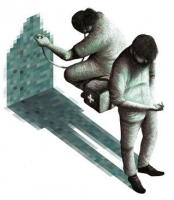“A medically accurate digital double could revolutionise your life” is the title of the article dedicated to VPH and the changes this technology could bring to everybody’s life in the next 20 years from now.

Linda Geddes, features editor at New Scientist, has interviewed some of the most important VPH spokespersons: our Executive Director, Prof Marco Viceconti (University of Sheffield), our Board Members, Prof Peter Coveney (UCL) and Prof Norbert Graf (University of Saarland) and the Chairman of the VPH Policy affairs work group, Liesbet Geris (University of Liege).
Each one of them has added a piece of the puzzle to better explain the VPH vision and its possible outcomes in simple terms.
With VPH “ Finally, we can say something about you: your condition, your history, your bad habits” says Prof Viceconti, presenting osteoporosis as a clear example in which a pure focus on genetics doesn’t tell you that much about your future risk of fracture if this data is not integrated with your personal health information such as the deteriorating of your eyesight or hearing, the strength of your muscles, your activity levels and posture.
“You can have a genomic blueprint, but it will not tell you precisely what’s going to come out at higher organisational levels,” says Peter Coveney .
To choose the best treatment option is also necessary to look at the body as a whole.“The links between different diseases aren’t always made,” says Liesbet Geris. “It’s often hard to envisage what the effect of medication for the heart problem will be on the diabetes, or how these two diseases will interact.”
The VPH solution is to build computer models that can combine the vast amounts of data about biological processes at the smallest scale – the workings of genes, proteins, and cells – with our growing understanding of whole-body systems. The models would simulate how the body’s microscopic machinery gives rise to everything else. This can then be integrated with a patient’s personal data, ultimately creating virtual models of us all.
“At the moment, doctors often have just one chance to get it right,” says Norbert Graf, “But if you have a virtual patient, you could select the treatment with the highest cure rate and the lowest toxic effect.”
Thanks to VPH in ten years from now each of us could grow a kind of twin, a digital body double that could be experimented on, testing outcomes for different drugs, surgical interventions and lifestyle choices.
The full article can be accessed from the New Scientist Magazine web-site